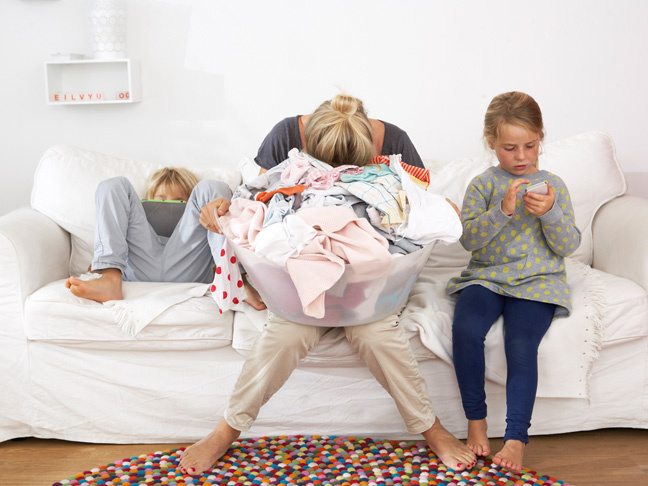
The job of a stay-at-home mom can be demanding and lonely. As mothers, we experience this overwhelming sense of the responsibilities of raising kids and caring for our homes.
Burnout can impact mothers who have careers outside of their homes as well. But SAHM burnout can be more difficult to spot because of misperceptions that we have more time, less stress, and an “easier” role than those who have additional responsibilities of working outside the home.
Besides typical life stressors, we also sometimes feel under appreciated and like we’re not doing enough because we aren’t contributing financially.
Managing stress as a mom is important for your mental health and the health of your family! Here are 5 ways you can start to cope with and prevent symptoms of burnout.

1. Be Real With Yourself
Stay-at-home moms may judge themselves for how they “should” feel. They may think, “I shouldn’t be stressed,” “I should be enjoying my time with the kids,” or “This should be easy.”
By ignoring feelings of burnout, many SAHMs become even further depleted and may experience depression. Being aware of and labeling how you feel is the first step in practicing emotional self-care, which is crucial for those who care for others 24/7.
You can’t tend to your emotions if you can’t identify them. Unfortunately, many of us get so busy that we forget to notice these feelings.
Start by checking in with yourself periodically throughout the day by asking, “What emotions am I feeling? How strongly am I feeling them from 0 to 10? What do I need right now?”
Practice listening to your answers and addressing your needs accordingly. You can even set a reminder on your phone to remind yourself.
If your anxiety is at a 10, take a break from the to-do list and go for a walk, focus on journaling, or try making a list of the things you are grateful for.
2. Create “Alone Time”
Incorporate time into your day that is just for you and not for anyone else in the family. Whether exercising or engaging in a creative outlet, this break is necessary for finding relief.
For instance, take 15 minutes to work out before jumping into the rest of your day. Doing so can seem impossible, but having a routine that includes time for yourself can actually make you more productive.
Taking care of yourself will also give you more energy to care for others!

3. Find Community & Support
Being a full-time caretaker comes with its own specific set of challenges, including isolation. SAHMs are typically home by themselves or with young children throughout the week.
Meeting other stay-at-home mothers can help you build a supportive community with those who understand your day-to-day life.
If you have toddlers, signing them up for “mommy and me” classes will help them make friends and offer opportunities for you to make mom friends. Gradually, you will start to feel more connected and like you have a community to rely on.
Even a quick phone or video call can make you feel connected to someone, especially if you don’t have many people to talk to during the week. Try calling a friend and purposefully talk about yourselves, without focusing on your kids or daily tasks.
Taking time for small outings, like going to a local coffee shop to interact with baristas or other customers, can also give you some human contact on a day when you’re feeling alone.
4. Declutter Your Home
Motherhood has enough emotions on its own without adding the extra stress and complications that can come with a cluttered home. Honestly, we tend to keep clutter around because it fills a void- whether that void is comfort, a need to escape, or happiness.
We hold onto things, or buy new things because we think it will give us comfort or joy. Or we go buy something new, or keep closets full of junk because we think somewhere buried in it is our key to happiness, and it’s not.
But keeping too many things has the opposite affect. Everything in your home and space is demanding your energy and attention.

The truth is, it’s emotionally draining to be surrounded by clutter. We get frustrated by the mess and annoyed cleaning the same things over and over again. It’s also really distracting.
Often, our things can actually make us feel suffocated, and like there isn’t room to breathe let along ENJOY each other’s company.
Our home should be our sanctuary- a place to rest and relax, and fill up each other’s love tanks. But when we are surrounded by junk, that just can’t happen as much.
Once we are no longer surrounded by messes, we get to see the things that really matter most to us. And we get to spend the time with the people who matter most to us.
5. Reframe What it Means to “Contribute”
Stay-at-home moms who feel they are not adding financial value to the household are more likely to experience negative emotions like guilt, shame, and sadness more intensely and frequently.
Reassessing what contributing to your household means can help you see daily responsibilities in a more positive and realistic light.
Then, you’ll start to see that planning and cooking healthy meals for your family, reading to and playing with your children, and being there when your kids come home from school are worthwhile and valuable aspects of staying at home.
Make a list of three things you did today for your family, and take a moment to appreciate how important your role is!

Leave a Reply
You must be logged in to post a comment.